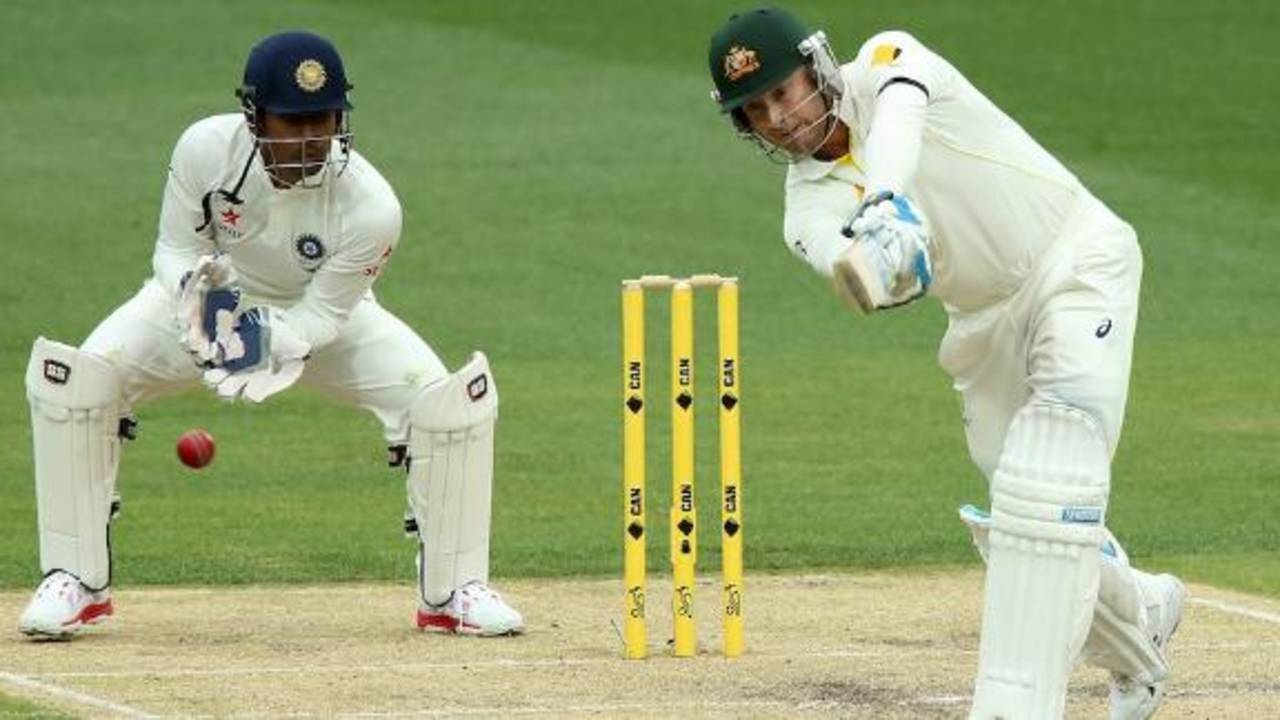Clarke broken but not beaten
The young Michael Clarke wouldn't recognise this broken old man. But he'd respect him. He'd want to be him, injury and all. Because Michael Clarke is now the hero he has wanted to be since he was born.
Jarrod Kimber at Adelaide Oval
10-Dec-2014
The last meaningful thing Michael Clarke did on day one was lay face down in the dirt and push at the ground. It is a pointless stretch when your back is that bad. It did nothing. Clarke had to hobble off the field. Physically limited, emotionally drained.
The rumours started early in the morning. They hit Twitter soon after. Clarke would bat. He was at the ground. He was in the nets. He was padded up. And then, as Steven Smith bounced onto the ground excitedly, next to him wasn't Mitchell Johnson, but a slightly rotund looking Michael Clarke.
Either wearing a backbrace, or as one Cricket Australia official joked, perhaps he'd eaten too much pasta the night before. Clarke was chunkier. Unlithe. Looking more former athlete, than current. Perhaps because of this, or the sparse damp crowd, it took just a little longer for people to notice it was Clarke on his way out.
The shots were different as well. He had brought back his bad-back pull shot. Part international cricketer, part old man moving items on a clothing rack. Cuts were dispatched, often without any need, or ability, to move the feet. Clarke even used the guide over the slips. It was mullet batting. Business on the pads, party outside off.
Clarke's leaves weren't authoritative or dismissive; they were jumpy and occasionally mildly hysterical. The inside edge of the bat would have been shocked with how much work it had to do. Clarke also gave the early waft, that to be fair, he can perform whether injured or not. He never truly seemed to get out the way of short balls, some just missed him as he shrugged his shoulders, ducked his neck and waited for impact.
Crossing from end to end may result in what we call runs, but it's overstating what Clarke was doing. Singles looked painful and resulted in much effort and little pace. Clarke would often lean forward, hoping the momentum would get him home. India threw the ball at his end like he was Arjuna Rantunga. Clarke completed four twos and one three. All of which looked like the end of marathons, not 44 or 66 yards. The bat seemed amazingly heavy in his hands, it always seemed clutched, not held. When running it seemed to be almost weighing him down.
When the rain first started, Clarke was the first man to start leaving the field. It was the only time he was the quickest to move. He looked dispirited when the umpires decided to play on. When they did leave the field later on, Smith ran off, Clarke walked slowly.
The stump microphone was more brutal on Clarke than any short ball. Heavy breathing and groaning became the soundtrack for his innings. A cricket phone sexline. If it was turned up louder, you could probably hear his spine clicking in and out of place. Louder still and you'd have heard the internal monologue of pain.

When he finally made the 100th run, he couldn't jump. He could barely raise his bat. It wasn't a celebration. It wasn't a testimonial. It wasn't a relief. It was just another struggle to overcome•Getty Images
The crowd applauded everything, even mishits to the legside that almost got runs. Clarke slashed hard outside offstump, and picked up singles off his hip on the legside. His feet moved to the spinner, but not in any meaningful or attacking way. It was Clarke on lithium. The Clarke we know since his back was attacked by this invisible troll.
Not sublime. Not silky. Not smooth. Sore. Slow. Skewed.
There was once a Clarke who danced down the wicket, slapped the ball without fear, and attacked like a desperate dog. It now seems like a dream, because the new version has been with us for so long. Crooked and cautious. New and unimproved, but still better. It scores important hundreds overseas. Can bat through bodyline tactics without any movement. Handles broken arms during an innings.
We've seen all this before. The stretching. The groaning. The slow movement. The target for short balls. The batting handicap. But this added something else.
Clarke has buried a friend. Fronted the media. Given a eulogy.
There were parts of Clarke's triple-hundred that appeared stage managed. His overcoming the back injury was done in private at Old Trafford. The hundred at the Gabba was punchy, admirable, but not epic. Cape Town might have had a broken arm, but it was a broken arm we found out about months later.
This was on the news. Front pages. Twitter. Facebook. Radio. Kitchen tables. Pubs. Trains. Offices. Schools. Everywhere.
When he made it to 98, India even went bodyline. But short of an asteroid landing on a good length, nothing ever looked like stopping Clarke. Career and life-ending problems confronted him, and he shuffled and slashed past them.
The young Michael Clarke wouldn't recognise this broken old man. But he'd respect him. He'd want to be him, injury and all. Because Michael Clarke is now the hero he has wanted to be since he was born. Not just A captain of Australia but one of THE captains of Australia.
When he finally made the 100th run, he couldn't jump. He could barely raise his bat. It wasn't a celebration. It wasn't a testimonial. It wasn't a relief. It was just another struggle to overcome. Clarke was restrained physically, restrained emotionally. His entire innings was the embodiment of what has happened to Australian cricket over the last fortnight.
Broken, but not beaten. And somehow, despite it all, stronger than before.
Jarrod Kimber was 50% of the Two Chucks, and is the mind responsible for cricketwithballs.com
